What is Thevenin's theoremIn electrical engineering, there are many laws, theorems, equations, formulas, and rules. Each of these theorems, formulas, laws, and rules typically serve a common purpose. Most commonly, we use ohms law, Kirchhoff's law in most of the circuits to find the value of voltage and current in the electrical circuits, but we must be known about the other circuit analysis theorems from which we can find the value of voltage and current at any given point or junction of the circuit. Among the multiple circuit theorems, Thevenin's theorem is most common. In this article, we will discuss Thevenin's theorem in detail. Thevenin's theoremThevenin's theorem states that an equivalent circuit can replace any linear circuit consisting of various resistances and voltages with a single source voltage and a series resistance connected across the load terminal. For example, in complex bridge circuits, we can easily find the balance condition by reducing the circuit into its Thevenin's equivalent. We can also find average power dissipated in the entire circuit rather than finding the power dissipated in each element and for that before finding current through each element. In other words, it is possible to simplify any electrical circuit, no matter how complex, to an equivalent two-terminal circuit with just a single constant voltage source in series with a resistance (or impedance) connected to a load. A Thevenin equivalent circuit is given below. In the given diagram, we can see that multiple resistive elements are replaced by a single equivalent resistance Rk and multiple voltage sources replaced by an equivalent source voltage Vk. 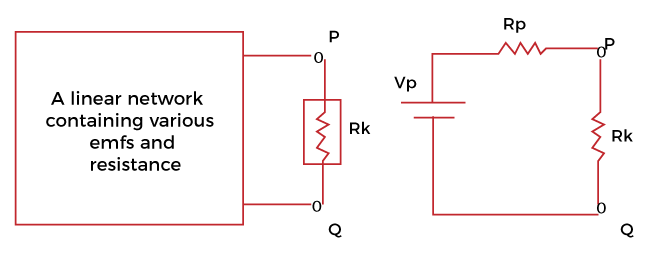
Advantages of Thevenin's Theorem
Thevenin's Theorem ExamplesLet's understand the concept of Thevenin's theorem with the help of an example. Example: 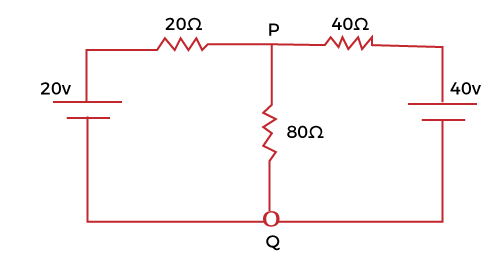
Step by step procedure to find the voltage and current using Thevenin's theorem Step 1 Analyzing the circuit Analyze the given circuit using Thevenin's theorem; first, you need to remove the load resistance located at the center. In this case, 80 ohms. Step 2 Shorting the voltage source Short the voltage source in the given circuit so that all the voltage source connected to the circuit is 0. If the current source is present in the given circuit, you need to remove the internal resistance by opening the source voltage. In this step, you will get an ideal voltage source and ideal current source for analysis. Step 3 Calculating the equivalent resistance To find the equivalent resistance of the given circuit, you need to follow the given step. 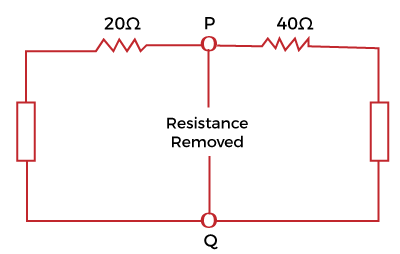
We have already removed the load resistance and shorted the source voltage; the circuit's equivalent resistance is determined as follows. The resistor 20 ohm is parallel to the 40-ohm resistor; therefore, the equivalent resistance of the circuit is given as 
Step 4 Calculating the Equivalent Voltage To find the equivalent voltage, you need to reconnect the voltage sources into the circuit that is Vk = Vpq; therefore, the flow of current around the loop is determined as 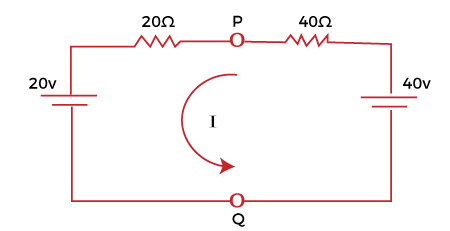
Applying ohms law in the given circuit to calculate the current We know that, 
Now, the determined current is the same to both the resistors; therefore, the voltage drop across the resistor is determined as Vxy = 40 - (40 * 0.33 A) = 26.8 V Or Vxy = 20 + (20 * 0.33 A) = 26.66 V The voltage drop across the resistors is almost the same. Step 5 Now, you need to draw Thevenin's equivalent circuit. The Thevenin's equivalent circuit comprises a source voltage of 26 V and a series resistance. 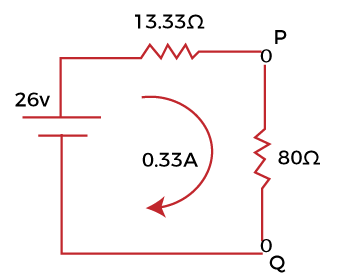
Therefore, the current flowing through the circuit is determined using the given formula. V = IR (Ohm's Law) 
You can apply Thevenin's theorem for both AC and DC circuits. But you need to ensure that this method can only be applied to AC circuits comprising linear elements like Inductor, Capacitor, and Resistors. Problem-based on Thevenin's TheoremQuestion 1: Find the current flowing through the circuit and Voltage across any load using Thevenin's Theorem? 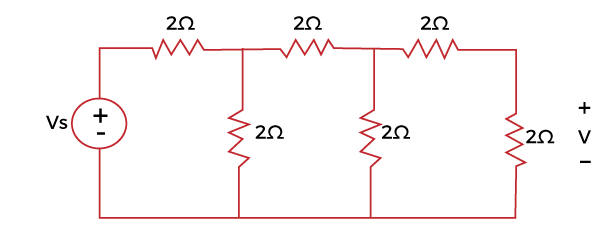
There are two methods to calculate the current and voltage using Thevenin's theorem.
The diagram given below depicts the problem. 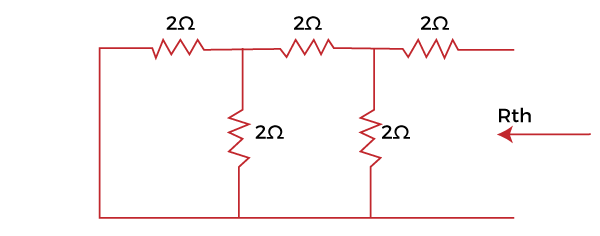
As the suggests, determining the Open Circuit Voltage needs us to open or remove the load. In our case, the load resistance is the rightmost '2-ohm' resistance that has a voltage of 'V' across it. Once we remove the voltage source, the open-circuit voltage (Voc) or Thevenin's voltage (Vth) is determined. The circuit with no load looks like 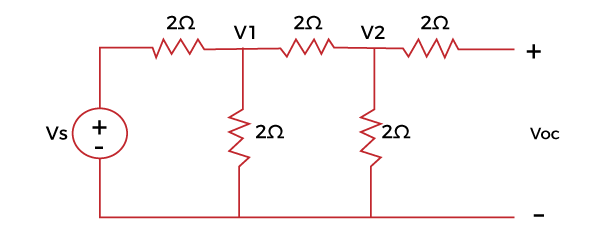
The open-circuit voltage Voc can be determined by using Kirchhoff's current law at nodes V1 and V2. Here, V2 = Voc. Applying KCL at node V1, we have Vs - V1 = V1 + V1 Vs+ Voc = 3V1 ……………. (1) Applying KCL at node Voc V1 - Voc = Voc V1 = 2Voc ……………… (2) Putting the value of V1 of equation 2 in equation 1, we get, Vs+ Voc = 3V1 Vs+ Voc= 3(2Voc) Vs = 6 Voc - Voc Vs = 5 Voc Voc = 0.2Vs Step 2 Finding the Thevenin Equivalent resistance. Before Thevenin's equivalent resistance is determined, you need to ensure the voltage sources must be short-circuited and current sources must be open-circuited. Since we have a voltage source (Vs), it is short-circuited, and the equivalent resistance (Rth) is determined. You can see the Rth in the given figure Rth can be calculated as = (2*2/2+2) + 2 = 1 + 2 = 3 = (3*2/3+2) + 2 = 6/5 + 2 = 3.2 ohm Once you calculate the Voc and Rth, you need to redraw the circuit as Voc in series with Rth connected across the load terminal is given as 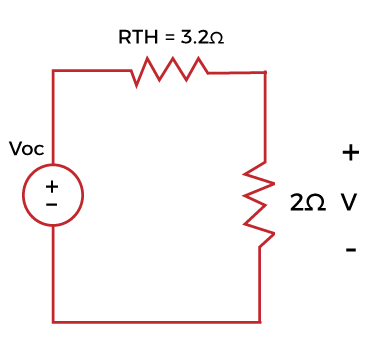
From the above circuit, the voltage V across the 2ohm resistor is given as V = Voc/(2 + 3.2 ) (Potential Division) Here, Voc = 0.2Vs. Putting the value of Voc into the above equation, we get Vs= 26 V |
 For Videos Join Our Youtube Channel: Join Now
For Videos Join Our Youtube Channel: Join Now
Feedback
- Send your Feedback to [email protected]
Help Others, Please Share









